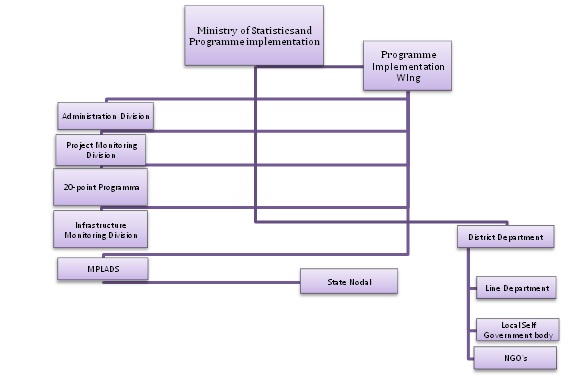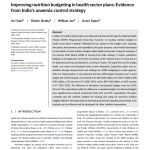
MPLADS – Learnings and stumbling blocks.
6 November 2013
Those familiar with the Indian political system will know of the roles and responsibilities of a member of parliament (MP). What do they do? If we were to go solely by news reports, hair-pulling, wielding microphones as weapons and occasional rioting form the bulk of the MP’s activity in parliament. However, MP’s are primarily known to don the part of a legislator- elected to debate & discuss issues of national importance, serve on committees and pass legislations of national relevance. The initiation of certain schemes, however, led to the coalescing of their duty as a legislator and that of performing executive functions. The passing of the Members of Parliament-Local Area Development Scheme (MPLADS) was such a decision. Now in its twentieth year, the scheme provides MPs a chance to not only route public money in areas that they believe need assistance in their constituency, but also expands their role as representatives of the people. Before delving into the controversial areas of the scheme, this blog tries to explore what the MPLADS is and what it aims to achieve.
The scheme, announced initially in 1993, began with the objective of creating sound and durable assets considered essential by the MPs for the development of their constituency. MPLADS laid the foundation for the type of works/projects that could be taken up by an MP with the aim of directing infrastructural development. This agenda began with the idea of providing basic amenities, such as drinking water or the construction of schools and roads. During the inception of the scheme, Rs 5 lakh was allocated to each MP to undertake certain projects. Between 1993 and 2013, the amount allocated has grown exponentially to reach Rs 5 crore[1]-, raising the annual expenditures from Rs 37.8 crore[2] when it began to Rs 3950 crore currently[3]. The increase in both entitlements as well as expenditures is staggering. MPs, of course, play the most important role within this framework. Not only do they recommend projects in and around their constituency, they also have the primary task of deciding the type of project, its length and required budget.
Financial devolution and monitoring
The Planning Commission has two ways in which funds are sent out: Central Assistance to State Plans and Grants through Central ministries. The MPLADS come under the former- as a Plan scheme where funds are sent out under the Special Central Assistance to States as Grant-in-Aids. The financial entitlement is sent in two instalments (Rs 2.5 crore each) by the Central Government, under the MOSPI (Ministry of Statistics and Programme Implementation) to the District Authority (Nodal District), first at the beginning of the financial year, and the rest after Utilization Certificates/Audit Certificates have been sent in by the District Authority. The funds that are released by the Central Government are non-lapsable and can be carried forward, and can be used by the next elected MP.
It is under the MOSPI that the monitoring of the MPLADS in each state is conducted. A look at the vertical structure of authority can be seen below. While the Programme Implementation Wing coordinates and ensures the functioning of the scheme, with evaluation & assessment inputs from the State Nodal Department, it is the District Authorities (usually the District Collector/District Magistrate/Deputy Commissioner of the area) that are at the forefront when it comes to monitoring the project closely, releasing the funds to implementing agencies on the ground, making sure all important reports are sent in, and supervising the works as well as submitting monthly progress reports[4]. A look at the monitoring and financial devolution of the scheme is given below.
Fig 1. Monitoring structure of MPLADS

Source: Details from the MPLADS Guidelines Report, 2012
Challenges and reflections
Some examples of successful projects (where projects have been completed) under MPLADS are those that have seen continuous participation from the MP at every level of its implementation. The completion of thousands of projects is a testament that MPs, implementing agencies, District Authorities and State Nodal Offices are following the books to some extent. Some states, primarily in the North-East and in the Northern regions (Punjab, Himachal Pradesh) have a high fund utilisation rate (view the total funds released, state-wise, here). In MOSPI’s latest report (2011-2012), it was stated that the total expenditure since the scheme was initiated, ran up to the tune of Rs. 24180.25 crore, coming to almost 89.4% expenditure incurred over the total released amount.
The implementation of this scheme (or lack, thereof) has rendered it in popular media as unworthy of continuously receiving large amounts of public money. News reports on the scheme focus largely on the various scams that are brimming. However, some steps have been taken recently, to reassess the monitoring and implementation of these projects. Last year, MOSPI announced the co-opting of MGNREGA works with MPLADS[5] – a positive step in ensuring that technical and labour support be given once the project has commenced. In addition to generating income and building infrastructure for the community[6], this decision also involves Zila Panchayats to provide a stamp of approval before the project is passed at the MOSPI level. Steps towards creating more transparency (besides having a one-sided progress report from the District Authority) have also begun. Back in 2011, MOSPI sent out feelers that they wanted to hire an independent firm that will inspect completed projects (similar to a social audit) to ensure the quality of the materials as well as the upkeep of previously completed projects[7]. With no official decision taken yet, the monitoring of the scheme remains ambiguous and does not exactly inspire confidence. Even a preliminary look will show that the scheme is riddled with challenges.
Initial planning and recommendations
As mentioned previously, there are vertical processes within MPLADS that involves MOSPI, District Authorities, MPs, local political entities and NGOs. Plans and works are recommended by MPs and sanctioned by the District Authority. It is only recently that panchayats at the local level had a say in these recommendations. To what extent are their recommendations given heed? Is there any community participation at all? Processes on how and where the funds should be utilized have been listed down under the Ministry’s Guidelines, but little or no information is available on where specifically the funds are allocated. How are plans to utilise funds made? Specific details on the coverage of the project, whether the project is feasible and the maintenance of the assets created is entirely missing.
Allocation and use of funds
As with the planning process, the details regarding use of funds is minimal. Which MP has spent what, recommendations by the local governments, months taken to complete the project, and with which implementing agency this was done, are nowhere to be seen on the government website. Overall allocations and expenditures at the state level form the majority of the data available. While the overall expenditure on MPLADS since its inception displays an extremely high percentage, the disparity across states is obvious (higher number of MPs = higher allocations per state). UP comes up as having the highest amount released by the government (which isn’t a surprise, considering the sheer number of MP’s[8] from the state). Delhi, Tamil Nadu and Mizoram have some of the highest utilization rates. Delays in payment from the Centre and time taken to send approvals also lead to projects either being carried forward to the next year, or them being shelved. Once these funds are received, the level of discretion given to the MP can instead lead to skewed development between districts, or the funds in some cases simply lie dormant in situations where re-elected MPs do not utilize them (to know which recurring MPs have not spent funds, click here). It is difficult to point out any one reason on why MPs do not channelize the funds into projects.
Mismanagement and mistrust
The Administrative Reforms commission’s 4th Report titled ‘Ethics in Governance’ (see here) a few years ago recommended that the MPLADS scheme be abolished. This was mentioned under the issue of using ‘Office for Profit’ and conflict of interest. MPLADS have been under criticism for being unconstitutional since most of the projects they undertake are already part of state lists and subsequent budgets, so what is the rationale of utilizing central funds for such a scheme? In 2010, the Supreme Court came out with a judgment that the MPLADS is NOT unconstitutional because of its inherent goal towards serving the public[9]. However, the lack of impact assessments and publically available audit details makes the scheme even more ambiguous. The CAG had once described the scheme as being the ‘most irregular and corrupt’ and of being ‘misused by MP’s for vested political interests’[10], and Yamini Aiyar’s earlier blog[11] also suggests that this scheme obfuscates accountability. The level of mistrust that this scheme has already generated in the last 20 years across party lines and civil society groups displays the level of suspicion that is now synonymous with the scheme.
The MPLADS is a perfect example of a scheme tailor-made for the elected members of parliament. The number of issues that remain to be addressed in the scheme, however, may possibly lead to its downfall. In addition to the widespread fear that government schemes are being used to channelize private profit, challenges like lack of community participation and conflict of interest still plague the initiative. Addressing the above through a thorough investigation of its impact will be useful for re-assessing the scheme’s feasibility and future course of action.
[1]NDTV. July 2011. Cabinet raises MPLAD fund from Rs 2 crore to Rs 5 crore. Accessible at http://www.ndtv.com/article/india/cabinet-raises-mplad-fund-from-rs-2-crore-to-rs-5-crore-117348
[2] Annual Report 2010-2011. http://mplads.nic.in/MPLADS-ENGLISH-AR-2010-11.PDF
[3] MPLADS Guidelines 2012. http://mplads.nic.in/mplads–guidelines-eng-2012.pdf
[4] Ibid.
[5] Press Information Bureau announcement. Convergence of MGNREGA with MPLADs. January, 2012.
[6] The Economic Times. http://articles.economictimes.indiatimes.com/2012-01-23/news/30655749_1_mplad-scheme-mplads-funds-durable-assets
[7] Zee news. Independent agency to review MPLAD http://zeenews.india.com/exclusive/independent-agency-to-review-mplad_3381.html
[8] Fifteenth Lok Sabha state-wise list. http://164.100.47.132/LssNew/Members/Statewiselist.aspx
[9] The Hindu. http://www.thehindu.com/news/national/nothing-unconstitutional-about-mplad-scheme-rules-supreme-court/article423882.ece
[10]Frontline. The Case against MPLADS. http://www.frontline.in/static/html/fl2122/stories/20041105005802400.htm
[11] Yamini Aiyar. SC Upholds MPLADs Scheme: A Questionable Judgement?- http://www.accountabilityindia.in/accountabilityblog/1184-sc-upholds-mplads-scheme-questionable-judgement





